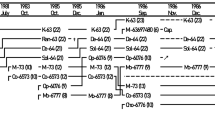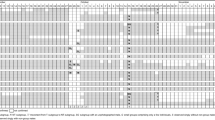Abstract
During a 16-month study of semifree-ranging Barbary macaques (Macaca sylvanus) the group under observation divided into two groups. Observations were carried out in 1987–1988, at «La Montagne des Singes,” Kintzheim, France. A subgroup of monkeys, which was already cohesive at the beginning of the study, became progressively autonomous in relation to the rest of the main group, during the mating season. Overt aggression between the males of the two groups during this period brought about the fission. Only low-ranking genealogies left their group of origin. Dominance relations between females remained identical in both groups except for one lineage. The alpha male and the alpha female of the subgroup had a close relationship before the fission occurred. The sequence of agonistic intergroup relations is described and analyzed in relation to male sexual competition and female alliance power. The results suggest that: (1) the males of the subgroup instigated the fission because it was the best strategy for them to counter sexual competition; and (2) the females followed the males in order to maintain their alliance network, necessary to insure their dominance status over subordinate females.
Similar content being viewed by others
References
Altmann, J., 1974. Observational study of behavior: Sampling methods.Behaviour, 49: 227–265.
Chance, M. R. A., G. R. Emory, &R. G. Payne, 1977. Status referents in long-tailed macaques (Macaca fascicularis): Precursors and effects of a female rebellion.Primates, 18: 611–632.
Chapais, B., 1983. Dominance, relatedness, and the structure of female relationships in rhesus monkeys. In:Primate Social Relationships: An Integrated approach,R. A. Hinde (ed.), Blackwell, Oxford, pp. 209–219.
————, 1986. Why do adult male and female rhesus monkeys affiliate during the mating season? In:The Cayo Santiago Macaques: History Behavior and Biology,R. Rawlins &M. Kessler (eds.), SUNY Press, Albany, pp. 173–200.
————, 1988. Rank maintenance in female Japanese macaques: Experimental evidence for social dependency.Behaviour, 104: 41–59.
----, in press. Role of alliances in the social inheritance of rank among female primates. In:Cooperation in Contests in Animals and Humans,A. Harcourt & F. de Waal (eds.), Oxford Univ. Press, Oxford.
———— &S. Schulman, 1980. An evolutionary model of female dominance relations in primates.J. Theoret. Biol., 82: 47–89.
Cheney, D., 1983. Extra-familial alliances among vervet monkeys. In:Primate Social Relationships: An Integrated Approach,R. A. Hinde (ed.), Blackwell, Oxford, pp. 278–285.
Chepko-Sade, D. B. &D. S. Sade, 1979. Patterns of group splitting within matrilineal kinship groups. A study of social group structure inMacaca mulatta (Cercopithecidae: Primates).Behav. Ecol. Sociobiol., 5: 67–87.
Datta, S., 1983. Relative power and the maintenance of dominance. In:Primate Social Relationships: An Integrated Approach,R. A. Hinde (ed.), Blackwell, Oxford, pp. 103–111.
Deag, J. M., 1973. Intergroup encounters in the wild Barbary macaqueMacaca sylvanus L. In:Comparative Ecology and Behaviour of Primates,R. P. Michael &J. H. Crook (eds.), Academic Press, London, pp. 315–373.
————, 1974. A study of the social behaviour and ecology of the wild Barbary macaqueMacaca sylvanus L. Ph.D. dissertation, Univ. of Bristol, Bristol.
———— &J. H. Crook, 1971. Social behaviour and “agonistic buffering” in the wild Barbary macaqueMacaca sylvanus L.Folia Primatol., 15: 183–200.
Dittus, W. P. J., 1982. Population regulation: the effects of severe environmental changes on the demography and behavior of wild toque macaques.Int. J. Primatol., 3: 276.
————, 1988. Group fission among wild toque macaques as a consequence of female resource competition and environmental stress.Anim. Behav., 36: 1626–1645.
Drickamer, L. C. &S. H. Vessey, 1973. Group changing in free-ranging male rhesus monkeys.Primates, 14: 359–368.
Furuya, Y., 1968. On the fission of troops of Japanese monkeys. I. Five fissions and social changes between 1955 and 1966 in the Gagyusan troop.Primates, 9: 323–350.
————, 1969. On the fission of troops of Japanese monkeys. II. General view of troop fission of Japanese monkeys.Primates, 10: 47–69.
Gouzoules, H., 1980. A description of genealogical rank changes in a troop of Japanese monkeys (Macaca fuscata).Primates, 21: 262–267.
Hunte, W. &J. Horrocks, 1986. Kin and non-kin interventions in the aggressive disputes of vervet monkeys.Behav. Ecol. Sociobiol., 20: 257–263.
Kawamura, S., 1958–65. Matriarchal social ranks in the Minoo-B troop: a study of the rank system of Japanese monkeys. In:Japanese Monkeys, A Collection of Translations,S. A. Altmann (ed.),S. A. Altmann, Edmonton, pp. 105–112.
Koyama, N., 1967. On dominance rank and kinship of a wild Japanese monkey troop in Arashiyama.Primates, 8: 189–216.
————, 1970. Changes in dominance rank and division of a wild Japanese monkey troop in Arashiyama.Primates, 11: 335–390.
Kuester, J. &A. Paul, 1988. Rank relations of juvenile and subadult natal males of Barbary macaques (Macaca sylvanus) at Affenberg Salem.Folia Primatol., 51: 33–44.
Loy, J. &K. Loy, 1974. Behavior of an all-juvenile group of rhesus monkeys.Amer. J. Phys. Anthropol., 40: 83–96.
Malik, I., P. K. Seth, &C. H. Southwick, 1985. Group fission in free-ranging rhesus monkeys of Tughlaqabad, Northern India.Int. J. Primatol., 6: 411–422.
Mehlman, P. T. &R. S. Parkhill, 1988. Intergroups interactions in wild Barbary macaques (Macaca sylvanus), Ghomaran Rif Mountains, Morocco.Amer. J. Primatol., 15: 31–44.
Missakian, E., 1973. The timing of fission among free-ranging rhesus monkeys.Amer. J. Phys. Anthropol., 38: 621–624.
Netto, W. J. &J. A. R. A. M. van Hooff, 1986. Conflict interference and the development of dominance relationships in immatureMacaca fascicularis. In:Primate Ontogeny, Cognition and Social Behaviour,J. G. Else &P. C. Lee (eds.), Cambridge Univ. Press, Cambridge, pp. 291–300.
Nishimura, A., 1973. The third fission of a Japanese monkey group at Takasakiyama. In:Behavioral Regulators of Behavior in Primates,C. R. Carpenter (ed.), Bucknell Univ. Press, Lewisburg, pp. 115–123.
Paul, A. &J. Kuester, 1985. Intergroup transfer and incest avoidance in semifree-ranging Barbary macaques (Macaca sylvanus) at Salem (FRG).Amer. J. Primatol., 8: 317–322.
———— & ————, 1987. Dominance, kinship and reproductive value in female Barbary macaques (Macaca sylvanus) at Affenberg Salem.Behav. Ecol. Sociobiol., 21: 323–331.
Pereira, M. E., 1988. Agonistic interactions of juvenile savanna baboons. I. Fundamental features.Ethology, 79: 195–217.
Sade, D. S., 1967. Determinants of dominance in a group of free-ranging rhesus monkeys. In:Social Communication Among Primates,J. Altmann (ed.), Univ. of Chicago Press, Chicago, pp. 99–104.
van Schaik, C. P., 1983. Why are diurnal primates living in groups?Behaviour, 85: 91–117.
Seyfarth, R. M., 1978. Social relationships among adult male and female baboons. II. Behaviour throughout the female reproductive cycle.Behaviour, 64: 227–247.
Smuts, B. B., 1983. Dynamics of “special relationships” between adult male and female olive baboons. In:Primate Social Relationships: An Integrated Approach,R. A. Hinde (ed.), Blackwell, Oxford, pp. 112–115.
————, 1985.Sex and Friendship in Baboons. Aldine, New York.
Sugiyama, Y., 1960. On the division of a natural troop of Japanese monkeys at Takasakiyama.Primates, 2: 109–148.
de Turkheim, G. &E. Merz, 1984. Breeding Barbary macaques in outdoor open enclosures. In:The Barbary Macaque: A Case Study in Conservation,J. E. Fa (ed.), Plenum Press, New York, pp. 241–261.
Walters, J., 1980. Interventions and the development of dominance relationships in female baboons.Folia Primatol., 34: 61–89.
Wrangham, R. W., 1980. An ecological model of female-bonded primate groups.Behaviour, 75: 262–300.
Yamagiwa, J., 1985. Socio-sexual factors of troop fission in wild Japanese monkeys (Macaca fuscata yakui) on yakushima Island, Japan.Primates, 26: 105–120.
Author information
Authors and Affiliations
About this article
Cite this article
Prud'Homme, J. Group fission in a semifree-ranging population of Barbary macaques (Macaca sylvanus). Primates 32, 9–22 (1991). https://doi.org/10.1007/BF02381597
Received:
Accepted:
Issue Date:
DOI: https://doi.org/10.1007/BF02381597




